Best Trail Camera That Sends Pictures To Your Phone
Hey there! Are you on the hunt for the best trail camera that can send pictures straight to your phone? Well, you've come to the right place! We've got you covered with our top picks that not only boast cutting-edge technology but also offer ultimate convenience.
We are supported by our audience. When you purchase through links on our site, we may earn an affiliate commission, at no extra cost for you. Learn more. Last update on 1st July 2025 / Images from Amazon Product Advertising API.
These cameras will let you effortlessly keep tabs on wildlife, monitor your property, or even capture breathtaking shots in the great outdoors. With these trail cameras, you can stay connected and never miss a single moment. It's like having the action right at your fingertips!
So, let's dive in and discover the perfect trail camera that will bring you closer to the wonders of nature.
Best Trail Camera That Sends Pictures To Your Phone
When it comes to finding the best trail camera that sends pictures to your phone, there are several top contenders to consider.
The Moultrie Mobile Edge Cellular Trail Camera 2 Pack offers nationwide coverage, HD video with audio, and cloud storage for your images.
Another option is the SPYPOINT LINK-MICRO-LTE TWIN PACK, which features 4G/LTE connectivity, 10MP photos, and a 0.5 second trigger speed.
Lastly, the Stealth Cam Fusion-X and Fusion X-Pro Cellular Trail Cameras are worth considering for their reliable performance and cellular capabilities.
Moultrie Mobile Edge Cellular Trail Camera 2 Pack | Auto Connect – Nationwide Coverage | HD Video-Audio | Built in Memory | Cloud Storage | 80 ft Low Glow IR LED Flash
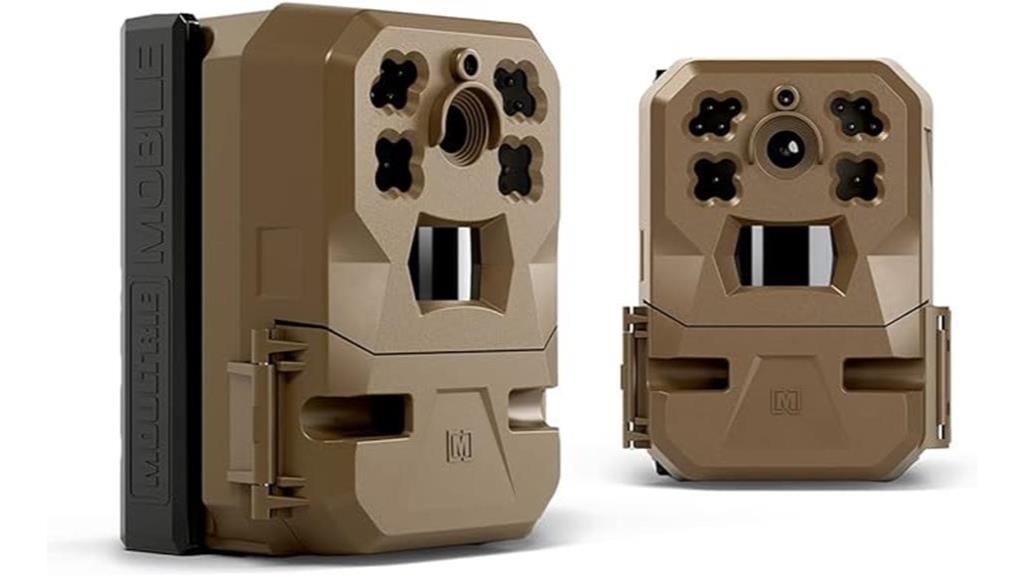
The Moultrie Mobile Edge Cellular Trail Camera 2 Pack is a must-have for wildlife enthusiasts and hunters who want to capture high-quality images and videos. Its standout features include the ability to easily connect and receive pictures on your phone, thanks to its auto-connect technology. This sets it apart from competitors that may require additional steps to access the footage.
With top-tier sensors, this camera produces sharp 33MP photos and HD 720p videos, ensuring exceptional detail in both day and night captures. The built-in 80 ft Low Glow IR LED flash provides clear night images without disturbing the wildlife.
Another major benefit is the camera's built-in memory and unlimited cloud storage. This allows for easy access to your game photos and eliminates the need to constantly change or delete memory cards.
While the Moultrie Mobile Edge Cellular Trail Camera 2 Pack offers convenience and reliability, one potential drawback is its reliance on 8 or 16 AA batteries for power. This may require frequent battery changes, especially if the camera is used frequently.
The target audience for this trail camera is wildlife enthusiasts, hunters, and outdoor photographers who value convenience and high-quality footage. Overall, the Moultrie Mobile Edge Cellular Trail Camera 2 Pack is an excellent choice for capturing wildlife footage with ease and reliability.
Moultrie Mobile Edge Cellular Trail Camera -Auto Connect – Nationwide Coverage – 720p Video with Audio – Built in Memory – Cloud Storage – 80 ft Low Glow IR LED Flash

The Moultrie Mobile Edge Cellular Trail Camera is a standout product for wildlife enthusiasts. Its auto-connect technology sets it apart from competitors, ensuring a seamless connection to your phone. With nationwide coverage, you can monitor your camera from anywhere, providing convenience and peace of mind.
The camera's ability to capture 720p videos with audio is a major benefit, delivering clear and detailed footage of your surroundings. It also boasts a built-in memory and unlimited cloud storage, allowing you to store all your captured photos and videos without worry.
The 80 ft low glow IR LED flash is another standout feature, enabling clear night captures without disturbing the wildlife.
The target audience for this trail camera includes wildlife photographers, hunters, and nature enthusiasts who want to capture high-quality footage without hassle. The camera's unique features, such as its auto-connect technology and nationwide coverage, make it a reliable choice for those who value convenience and accessibility.
However, it's worth noting that the camera's 720p video resolution may not be on par with some higher-end models. Nevertheless, the Moultrie Mobile Edge Cellular Trail Camera offers a compelling package for anyone looking to document wildlife activity with ease and reliability.
SPYPOINT LINK-MICRO-LTE TWIN PACK Cellular Trail Cameras – 4G/LTE,10MP Photos,Night Vision 4 LED Infrared Flash 80' Detection Range, 0.5S Responsive Trigger Speed,Cell Cameras for Hunting-For USA only
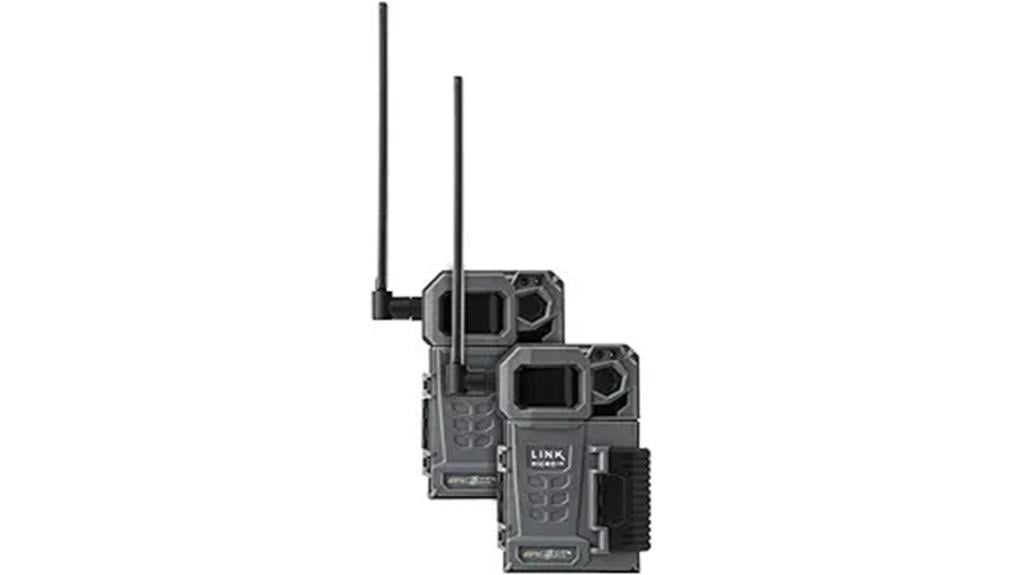
The SPYPOINT LINK-MICRO-LTE TWIN PACK cellular trail cameras are a game-changer for hunters in the USA. These cameras stand out from competitors with their exceptional 4G/LTE connectivity, allowing you to receive high-quality 10MP photos directly to your phone, no matter your location.
The night vision feature, equipped with a 4 LED infrared flash, ensures clear and detailed images even in low-light conditions. With an impressive 80' detection range and a responsive trigger speed of 0.5 seconds, you'll never miss a moment.
The compact and easily concealable design is ideal for hunting, providing an advantage when tracking game or deterring trespassers. SPYPOINT offers cost-saving benefits like saving on gas and plans, keeping scent out of the woods, and a free photo plan option with the ability to purchase HD photos.
The target audience for these cellular trail cameras are hunters looking for convenience, performance, and the ability to remotely monitor their hunting areas. The major benefits of the SPYPOINT LINK-MICRO-LTE TWIN PACK include its advanced connectivity, superior night vision, and compact design.
One potential drawback could be the dependence on cellular coverage in remote hunting locations. Overall, these cameras are a valuable tool for enhancing hunting experiences.
Moultrie Mobile Edge Cellular Trail Camera -Auto Connect – Nationwide Coverage – 720p Video with Audio – Built in Memory – Cloud Storage – 80 ft Low Glow IR LED Flash
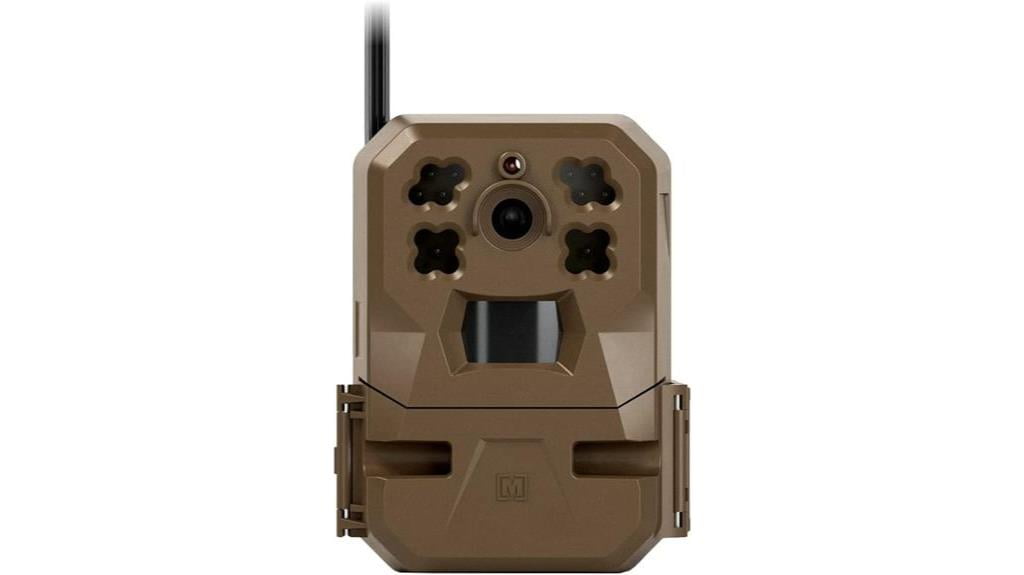
The Moultrie Mobile Edge Cellular Trail Camera is a game-changer for outdoor enthusiasts and homeowners alike. Unlike its competitors, this trail camera offers a unique auto connect feature and nationwide coverage, ensuring that you can effortlessly capture stunning 720p videos with audio and receive them directly to your phone. The built-in memory and unlimited cloud storage provide seamless connectivity and peace of mind, as you never have to worry about running out of space for your footage.
One major advantage of the Moultrie Mobile Edge is its 80 ft low glow IR LED flash, which allows you to capture clear and detailed footage day and night. This is a standout feature compared to other trail cameras on the market. Additionally, the camera offers flexible power options, allowing you to choose between using 8 or 16 AA batteries.
The target audience for this trail camera includes hunters, wildlife observers, and individuals looking to enhance their home security. Whether you're monitoring game trails, observing wildlife behavior, or keeping an eye on your property, the Moultrie Mobile Edge Cellular Trail Camera delivers high-quality videos and photos directly to your phone, providing you with the convenience and peace of mind you deserve.
While this trail camera has many benefits, it's important to note that the Moultrie Mobile Edge doesn't support live streaming. However, considering its other outstanding features, this drawback is easily overshadowed by its overall performance and reliability.
Stealth Cam Fusion-X and Fusion X-Pro Cellular Trail Cameras
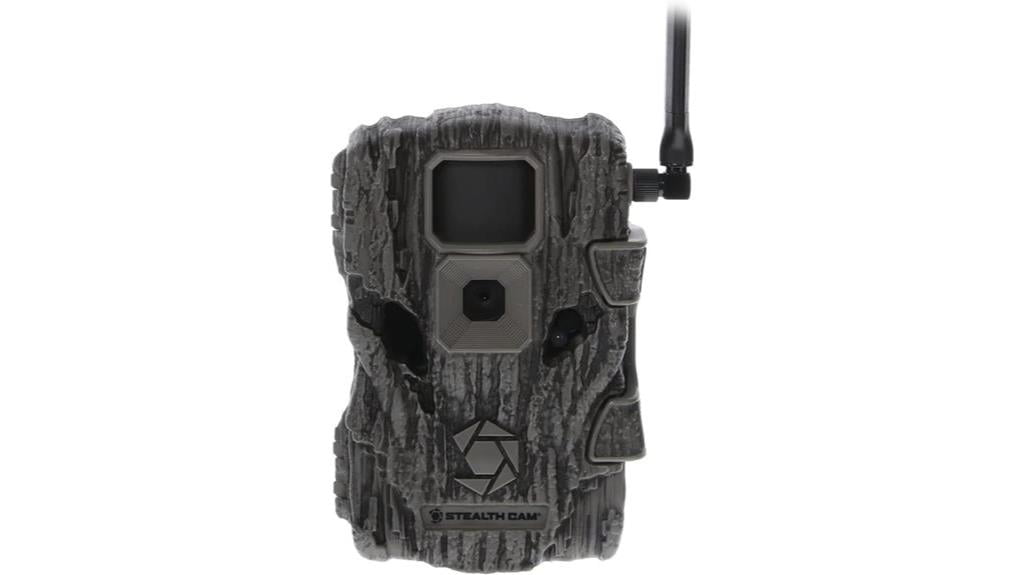
The Stealth Cam Fusion-X and Fusion X-Pro Cellular Trail Cameras stand out from their competitors with their exceptional wireless capabilities. These cellular trail cameras allow you to receive high-quality pictures directly to your phone, providing instant access to your trail camera footage. With adjustable photo and video resolutions, you can customize the image quality to your liking. The quick trigger speed and 80ft range ensure that you capture every moment without any delay.
One major benefit of these cameras is their long battery life, operating on 8AA batteries. This ensures that you can rely on them to capture footage for extended periods without constantly needing to replace the batteries.
The target audience for the Stealth Cam Fusion-X and Fusion X-Pro Cellular Trail Cameras are outdoor enthusiasts, hunters, and wildlife researchers who require real-time access to trail camera footage. These cameras provide convenience and ease of use by eliminating the need to manually retrieve SD cards from the camera.
A potential drawback of these cameras is the reliance on cellular network coverage. If you're in an area with weak or no signal, you may experience delays in receiving the pictures or videos. However, overall, the Stealth Cam Fusion-X and Fusion X-Pro Cellular Trail Cameras are excellent choices for those seeking a trail camera that provides wireless capabilities and instant access to footage on their phone.
SPYPOINT LM2 Cellular Trail Camera – 20MP Photos, Infrared Game Night Vision Photos, 90' Flash Camera & Detection Range, 0.5S Trigger Speed, Optimized Antenna, Photos Sent to App (VNZ)
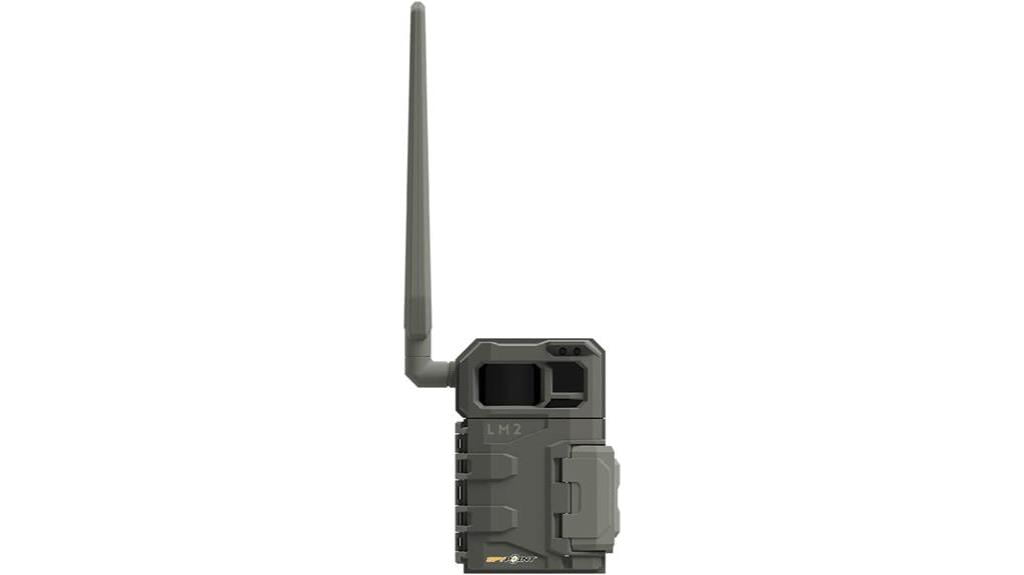
The SPYPOINT LM2 Cellular Trail Camera stands out among its competitors with its impressive features and capabilities. It's a great option for outdoor enthusiasts, hunters, and wildlife researchers who want a trail camera that can send high-quality pictures directly to their phone.
With its 20MP photos, infrared game night vision photos, and 90' flash camera and detection range, this camera ensures clear and detailed images day or night. The 0.5s trigger speed guarantees that you never miss a moment, and the optimized antenna ensures reliable transmission of the photos to the SPYPOINT app.
One major benefit of this cellular trail camera is its user-friendly design and easy concealment, making it a convenient tool for scouting and hunting. Additionally, the option to subscribe to additional benefits, such as HD and video packages, provides a seamless and efficient way to keep an eye on your property or wildlife from anywhere.
While the SPYPOINT LM2 Cellular Trail Camera offers a range of impressive features, one potential drawback is the need for a subscription to access all its features. However, for those who value the convenience and advanced capabilities provided by this camera, the subscription may be worth it.
SPYPOINT LINK-MICRO-LTE-V Cellular Trail Camera-4 LED Infrared Flash with 80'f Detection and Motion Sensor, LTECapable Cellular Game Camera 10MP 0.5sec Trigger Speed, Cell Cameras for Hunting-USA only
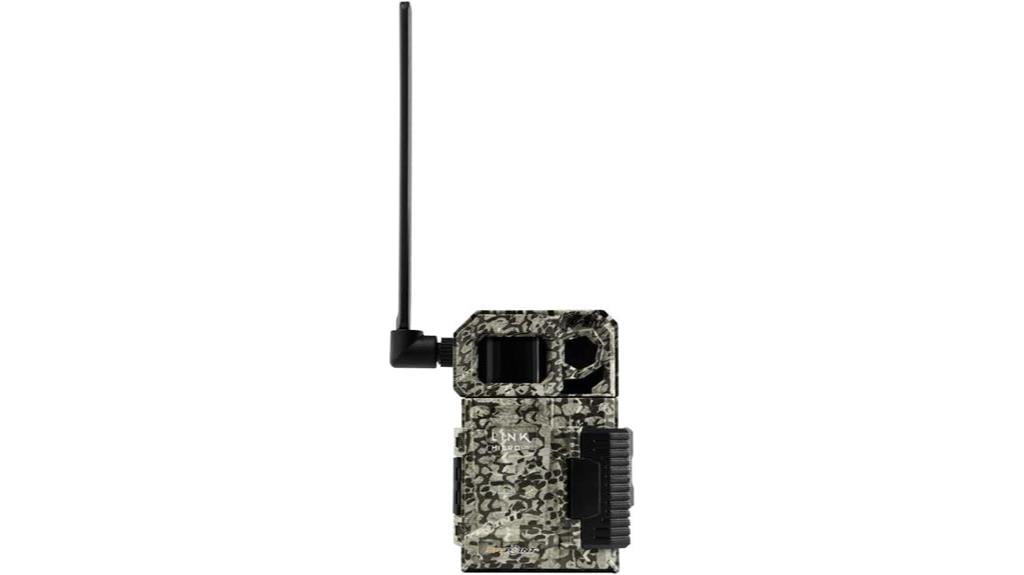
The SPYPOINT LINK-MICRO-LTE-V Cellular Trail Camera is a must-have for hunters in the USA. Its standout feature is the 4 LED Infrared Flash with 80'f Detection and Motion Sensor, ensuring clear and detailed images even in low light conditions. Unlike other trail cameras, this one is LTE capable, allowing you to receive photos directly on your phone without the hassle of swapping SD cards. With a quick 10MP 0.5sec Trigger Speed, you won't miss any important moments. The compact design of this camera makes it easy to conceal and minimizes its impact on game.
Compared to competitors, the SPYPOINT LINK-MICRO-LTE-V offers the convenience of instant photo delivery and a faster trigger speed. This saves time and effort, giving hunters an edge in their scouting activities.
The major benefit of this camera is its ability to send photos directly to your phone, eliminating the need for physical retrieval and reducing the risk of disturbing the area. However, it's important to note that this camera is only available for use in the USA.
The target audience for the SPYPOINT LINK-MICRO-LTE-V Cellular Trail Camera is hunters who prioritize convenience, efficiency, and staying updated on their scouting efforts. Whether you're a professional or a hobbyist, this camera will enhance your hunting experience.
Muddy – Mitigator Cellular Camera / 24Mp / On-Demand Photo/Dual Network (MUD-MTGTR)
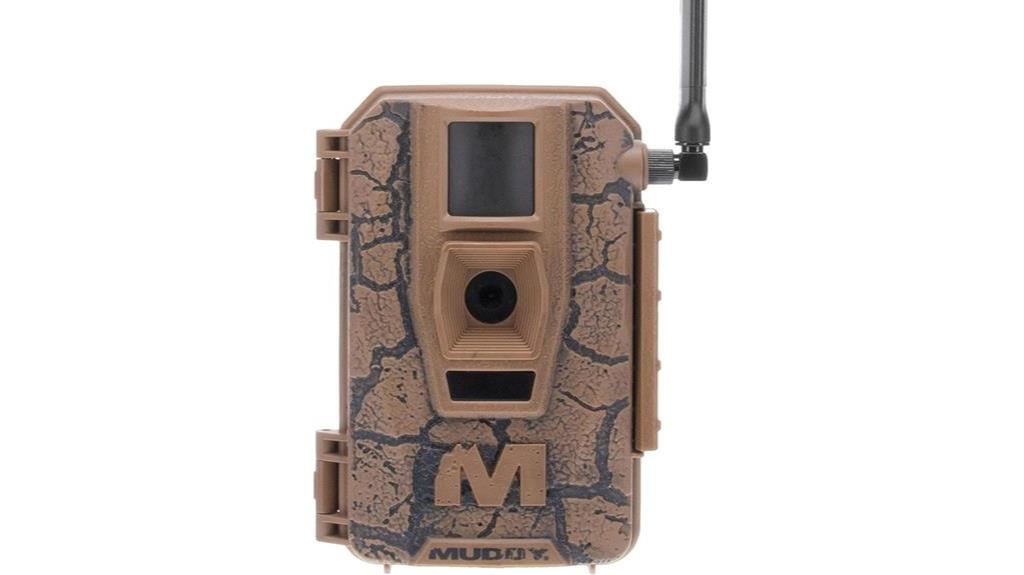
The Muddy Mitigator Cellular Camera is the ultimate trail camera for outdoor enthusiasts. With its impressive 24MP photo resolution, it delivers high-quality images that surpass the competition. One standout feature is its on-demand photo transmission, allowing you to receive pictures directly to your phone whenever you want. This convenience sets it apart from other trail cameras on the market.
Furthermore, the Muddy Mitigator offers dual network coverage, ensuring a reliable connection no matter where you're in the wilderness. Its adjustable PIR sensor and quick trigger speed of 0.7 seconds guarantee that you won't miss any action, capturing even the most fleeting moments.
Another advantage is its support for SD memory cards up to 32GB, providing ample storage for your pictures. However, it's worth noting that this camera mightn't be the most budget-friendly option.
The Muddy Mitigator Cellular Camera is perfect for outdoor enthusiasts who want to capture stunning images and conveniently receive them on their phone. Whether you're a wildlife enthusiast, hunter, or nature photographer, this trail camera is a top choice for its exceptional features and reliability.
Stealth Cam DECEPTOR Camera, 40MP, Dual Network, On-Demand Photo, Cracked Mud Camo
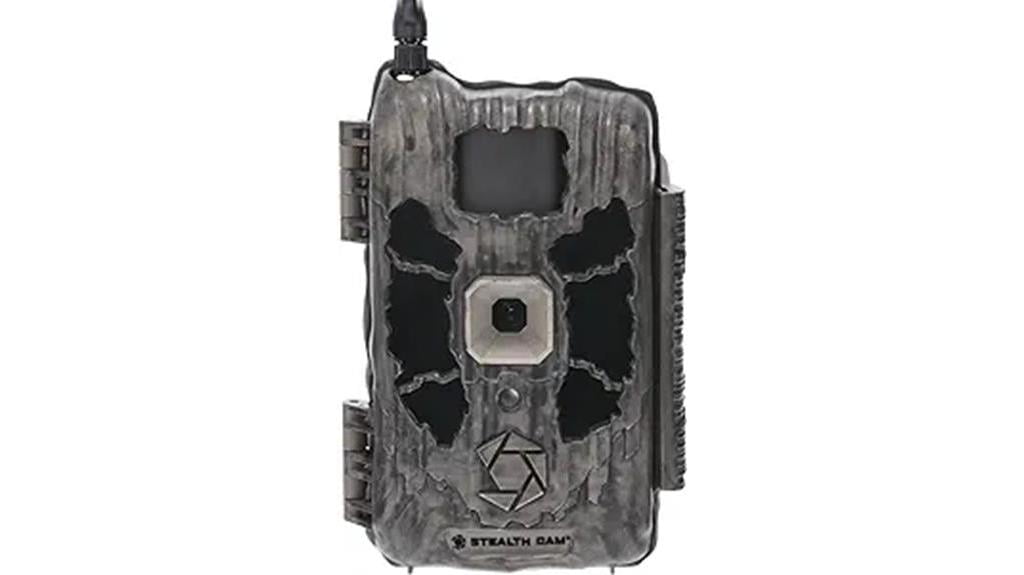
The Stealth Cam DECEPTOR Camera is a game-changer in the world of trail cameras. With its impressive 40MP photo resolution, it surpasses its competitors, delivering stunningly detailed images that truly capture the essence of your outdoor adventures.
The dual network capability sets it apart from other trail cameras, ensuring a reliable and consistent connection for on-demand photo transmission. This feature is particularly beneficial for those who want real-time access to their photos.
The camera's cracked mud camo pattern is a unique design choice that allows it to blend seamlessly into its surroundings, making it almost invisible to wildlife.
The quick trigger speed of 0.3 seconds is another major advantage, ensuring that you never miss a crucial moment.
Whether you're a professional wildlife photographer or an avid nature enthusiast, the Stealth Cam DECEPTOR Camera is a must-have tool for capturing and sharing your outdoor experiences. Its target audience includes outdoor enthusiasts, wildlife photographers, and anyone who wants to document their adventures with high-quality photos.
The only drawback of this camera is its higher price compared to some competitors, but the superior features and performance justify the investment.
Conclusion
In conclusion, when searching for the best trail camera that sends pictures to your phone, it's crucial to consider factors such as:
- Image quality
- Battery life
- Connectivity options
- Durability
By choosing a camera that excels in these areas, you can ensure a seamless and reliable experience.
Remember to:
- Research customer reviews
- Compare different models
Find the perfect option that suits your needs and preferences.
Happy trail camera shopping!
